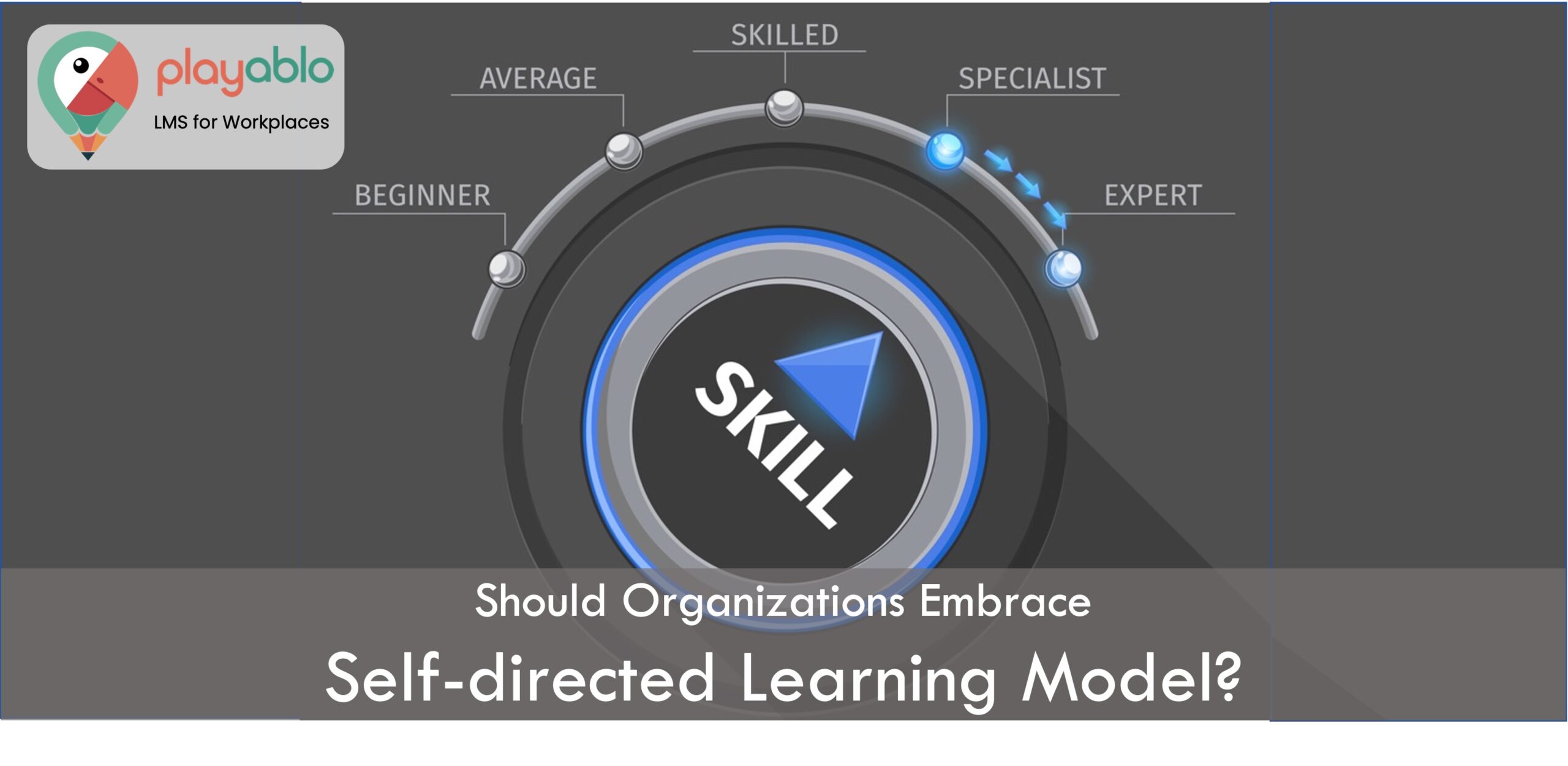Technology advancements, digital shopping experiences, social media, and an abundance of real-time information sources have accelerated the evolution of how individuals learn about and interact with businesses. As the barrier between sales and CRM shrinks, it’s unsurprising that this trend affects the workplace. Employees want decentralized, flexible, and digital content-rich self-directed learning programs. As a result, Self-Directed Learning (SDL) has grown in popularity as businesses look for new ways to educate personnel and provide engaging, meaningful experiences for both customers and learners.
Table of Contents
Self-directed learning: An introduction
The obligation for learning is transferred from the educator to the trainee in self-directed training. When it pertains to learning, this allows the learner to make all of the decisions.
Assume your employer has asked you to organize a workplace party. Some would argue that freely deciding on the location for your party is an example of self-directed learning. In truth, self-directed training entails more than merely picking a location. It’s all about figuring out how personnel will reach the location. When they should arrive, and what they’ll eat and drink. Surprisingly, it’s also about debating why you’re throwing a party at this point.
Self-directed learning differs from other approaches since it enables people to control their learning; rather than being told what to do, learners are trained to comprehend the fundamentals of a task by deciding whether and what they really want to learn and how they would like to understand it. When it concerns self-directed learning, the most crucial component is that you must be able to choose what you want to study.
Why is self-directed learning so powerful?

Human neurology underpins SDL’s efficacy. It seems like a revelation when you uncover anything on your own. It’s thrilling. It makes employees happy. It releases a flood of endorphins that satisfy their curiosity and the time and effort learners put into studying and exploring. When these emotions are linked to a specific circumstance, product, action, or achievement, the natural impulse is to dig deeper—to know much more. Regardless of how attractive the message is, this is far more powerful than being taught or shown stuff. SDL enables individuals to progress at their pace and provides genuine exhilarating moments that guarantee success when properly designed.
Employees need more authority and involvement
94 percent of employees think they would stay at a firm longer if it invested in their learning and development, according to the 2020 LinkedIn Workplace Learning Report. In particular, millennials and Generation Z respondents want entirely self-directed learning alternatives.
Employees are placed in the driving seat at SDL, giving them the charge. SDL, however, is not a hands-off approach, despite its name. It takes a well-thought-out ID strategy, the correct educational sources, the appropriate technology platform, and skilled moderators to guarantee that:
- Learning requirements are correctly identified and assessed.
- Goals are set that are quantifiable and reasonable.
- The training content is up to date, effective, and easily accessible.
- Long-term success requires management buy-in.
We understand that people want and demand authenticity. As firms strive to build appropriate training methods that help employees engage, enlighten, and educate, the need of migrating from “sage on the stage” to “guide on the side” has never been more critical. The main difference is that younger employees like to pull knowledge toward them rather than have management push it upon them.
This implies that any SDL program should emphasize contextual and situational findings that provide a deeper understanding of the client and relevant, real-world tales that enable genuine, product-based communication. Consider the following three ideas:
What are the elements of self-directed learning?

Consider training objectives like marketing goals
Video marketing has risen in popularity in recent years, with 70% of marketers claiming that video content has a favorable ROI. Corporate training programs, which have depended on videos that are much too long and dull, could learn from digital marketing media methods.
For instance, a collection of short-form clips on various themes and scenarios may be hosted on YouTube, helping employees explore topics at their leisure and in-depth. Video content will be concentrated and easily consumable if each asset is centered on one situation or skill.
Use online training programs for individuals seeking experience and accreditation in online marketing and lead creation. Make use of video marketing in a variety of formats. Case studies, accomplishments, podcasts, manuals, and training materials can all be uploaded.
Enable employees to create their own training materials
With scenarios that assist in solving problems and modifying perceptions, training should meet real-world client needs and present mindsets. Employee participation in training subject themes will stimulate suggestions for additional pain points or possibilities they may have with customer contacts, technologies, and real-world applications.
How the younger generation views buying automobiles and, more significantly, engaging with auto dealerships is a commonly acknowledged customer pain issue in the commercial, automotive industry. Millennials buy automobiles, but they despise the inconvenience and aggressive sales tactics car dealerships use.
Consider a training program that allows employees to work in small groups to create meaningful encounters that address current regional challenges. Participants get more invested as a result; learning will become more of a session, where salespeople are assisted rather than given a lecture.
Connect self-learning employees with clients
Engaging with different consumers is easier when businesses meet them where they are in a genuinely honest manner. Customers value being advised by experts who are also customers, who know them intimately, know what they’re thinking, and know what they ultimately require.
For instance, web-savvy staff can detect a marketing effort a mile away, so throwing a salesperson into a fully formed group isn’t going to cut it. Not only a 21st-century speech, but modern sales must also be an inner resource conveying informative assets from the maker to ethnic customer segments.
What are the pros and cons of self-directed learning?

Is self-directed learning the most effective method for assisting employees in evolving and developing new skill sets? Like all concepts and training methodologies, self-directed training offers advantages and disadvantages.
Pros
Employees gain specific knowledge in the different areas
Employees who get the freedom to select their instructional methods have the opportunity to learn skills that they are genuinely interested in or require. The more invested they are in what they’re learning, the more likely they are to master the skill.
The learning path adapts to the demands of the learner
We all learn in different ways. Not everyone absorbs or understands knowledge at the same rate or in the same way; some of us prefer reading while others prefer doing. The self-directed learning paradigm defies convention by allowing students to do as they like and learn in the way they prefer.
Self-learners have a profound instead of a superficial learning experience.
When an educator teaches a task in a straightforward way, the learner may only learn the task. A learner who follows a self-guided learning route comprehends and implements the task’s notion. This is the primary distinction between profound and superficial learning. In the self-directed learning scenario, learners critically consider and genuinely comprehend the task. Because of the instructor’s “spoon-feeding” information, superficial learning is nothing more than memory.
Cons

Not everyone might find it simple.
This approach implies that to maximize their learning potential, students need the flexibility to work at their speed and with their tactics. This isn’t always the case, though. Some students require assistance to grasp key concepts, particularly when studying new or complex subjects. Obviously, SDL does not imply that students must do all of the work themselves. Self-paced courses could be supplemented with a live, instructor-led course.
Biases may get in the way.
There is no assurance that learners will obtain the targeted teachings or ideas from a program if they are permitted to learn without assistance or even monitoring. This is particularly true in a company where people come from various demographics, such as culture, opinions, ethics, age, and ethnicity.
Too much freedom can hinder learning.
Is it possible to have too much freedom? Some people feel it is possible. Some people may be overwhelmed by the number of options available to them when it involves dealing with chores and addressing issues. There’s also the issue of self-discipline to consider. Employees who participate in self-directed training must stay committed to returning to training regularly. Freedom is an issue for ambitious self-learners since so many individuals struggle to keep to practice without some accountability.
Notwithstanding a few drawbacks, many people consider self-directed learning among the most efficient learning systems ever devised. If some minor adjustments are required for specific learners, go ahead and make them. After all, the idea is to bring everyone on board, even if it requires time.
How to implement self-directed learning in your organization?
It’s not as simple as buying the correct books for your HR department to implement self-directed learning in your business. It’s more than simply a program; it’s a shift in your company’s overall culture. Getting everybody on board and trusting in self-directed learning may be the most challenging obstacle you’ll face in corporate HR, but it’ll be one of the most satisfying things if you succeed over time.
Prep up your staff
Take a systematic approach. Begin by persuading, particularly hesitant, employees of the advantages of improving their workplace abilities. Make them feel enthusiastic about establishing their learning plan. Encourage employees to seek advice from your human resources department or their boss if they are unclear about where to begin.
Employees must also be aware of their possibilities. Take them on a tour” of your web-based library so they can view all of the learning resources and skills they can acquire. If you’re employing specialist resources, such as a virtual learning system like an LMS, make sure your staff, including those who aren’t tech-savvy, understand how to use them.
Ad: PlayAblo’s Enterprise-Grade Micro-Learning platform is built for millennial learners. Micro-Learning, along with assessments and gamification features, ensures learning outcome measurement and sustained engagement.
Find out more and request a custom demo!
Select resources that complement self-directed learning

If staff is going to study independently, you must ensure they don’t run into any roadblocks. First, get a Learning Management System that keeps your learning materials organized and accessible. Choose a user-friendly LMS that can accommodate various content types, from introductory videos and prose to simulations.
Keep in mind that studying involves some mental exertion. As a result, strive to provide employees with bite-sized resources that won’t add to their cognitive load. Easy-to-digest content such as visuals, learning cards, 5-minute films, and fast quizzes make learning enjoyable and simple.
Offer a variety of learning types
Offering a range of learning materials will cater to diverse learning styles, but it will also keep things fresh. Some people prefer to study through lessons rather than through online training courses. Develop your courses, purchase ready-made training courses, or look for free online training classes. Allow employees to browse and select what they want to study next.
For individuals who aren’t willing to commit to a class, share information, survey results, analyses, and publications to keep them informed about industry trends. Keep a lookout for webinars and other learning opportunities that might interest your personnel. One-time events can still provide a suitable dosage of information and, more importantly, keep the desire to learn fresh.
Target devoted learning groups
Establish an entire learning community for staff who are pursuing self-directed learning so they may share their ideas and expertise. Employees with more experience can offer suggestions for learning tools and solutions to learner inquiries.
Self-directed learning must also include peer-based interaction. It’s one of the most effective strategies to avoid online learning fatigue since it keeps employees engaged and inspires others to do the same. Workers get to know coworkers from various departments better as a side benefit, which can only strengthen your team.
Embed self-directed learning in daily work
Experts claim that if you want to do something, you’ll figure out a method to make it happen. However, this is possibly the most prime example of something which sounds easier said than done. How can employees find the required time and energy to study when they have so many things to do besides work?
As a result, all employees should be able to set aside time each week for professional growth. Allow them to clear their schedule for a few hours each week to practice a new ability until it becomes a habit at work. They’ll take a well-deserved break from their work, learn new things and intriguing, and come back to work more efficient and rejuvenated.
Conclusion
Whether using an iPad to study our future car, browsing movie reviews to make selections, or viewing user-generated material on how to dismantle a washer when it clunks, we are already self-directed learning consumers. Companies that ignore SDL do so at their risk and chance of appearing out of touch.
However, keep in mind that the transition to self-directed training will take time. It’s just a matter of cleaning up the atmosphere in your office and showing your staff that you’re taking steps toward a more pleasant and open environment. It requires patience, just like any other habit or culture. Self-directed learning will start to emerge once this has been created, sometimes without your knowledge!
Ad: PlayAblo’s Enterprise-Grade Micro-Learning platform is built for millennial learners. Micro-Learning, along with assessments and gamification features, ensures learning outcome measurement and sustained engagement.
Find out more and request a custom demo!







Comments are closed, but trackbacks and pingbacks are open.